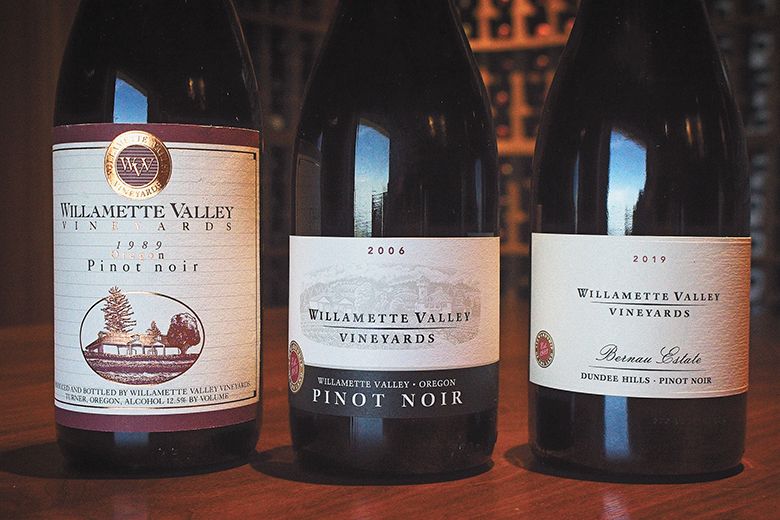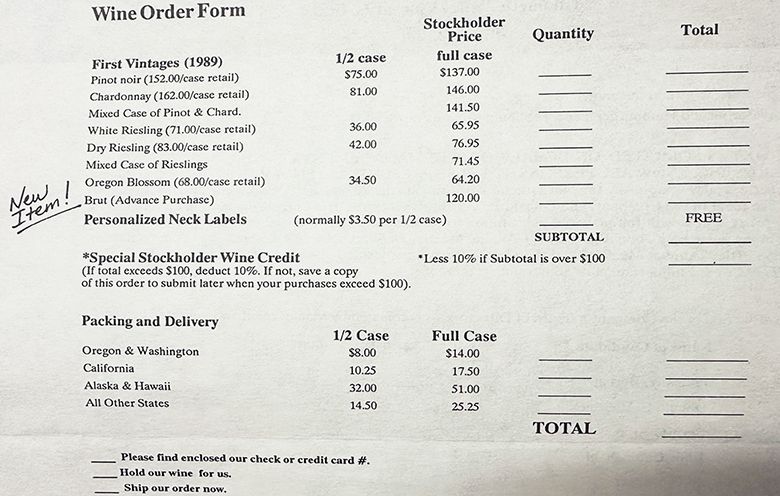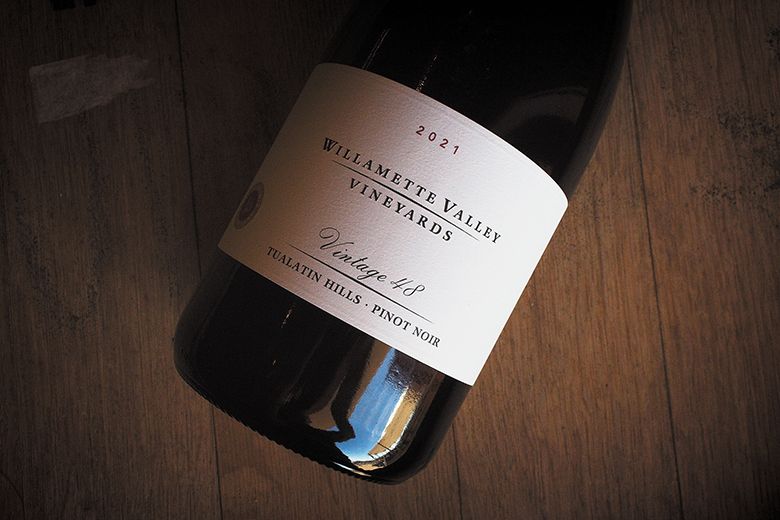Labeling the Legacy
A history of the wine labels used by both Willamette Valley Vineyards and Tualatin Estate








By Kerry McDaniel Boenisch
From a 15-acre Pinot Noir planting in 1983, Willamette Valley Vineyards is now one of the largest winery enterprises in Oregon, growing retail sales by 31 percent to $20.7 million in 2023. With 10 locations, total sales of over $39 million increased by over $5 million year-over-year.
How did this happen?
I took an in-depth look at the Willamette Valley Vineyards’ wine labels. They show an evolutionary timeline showcasing CEO and founder Jim Bernau’s determination in the early years through the remarkable success of the present. Here is the narrative, the hard work, industry support and luck along the way….
When you started in the wine industry, what was the significance of your first label and what did you set out to do?
The label on our first vintage (1989) was of our cellar. We carefully built the winery between a grand old Douglas Fir and a maple tree that must have shaded the indigenous people two centuries ago. It was inexpensively designed, printed and hand glued onto the bottles. Our small production meant nearly all the wine was sold at retail prices from the cellar door.
Several years later, we added an architect’s rendering of the entire winery. It was aspirational as we didn’t have the funds to construct it in its entirety. Yet, we wanted to prove it could be done– that we could produce world-class Pinot Noir from the Willamette Valley while serving as stewards of the land.
As I learned more, Oregon’s many microclimates and soils revealed an even bigger opportunity. How best to tell the “Oregon” story through wine? I was convinced we could accomplish this by relying on respectful collaboration among industry advocates and winery ownership by many wine enthusiasts from all walks of life.
You found an order form for your first vintage in 1989, which you sold by the full case at retail for $152 and discounted half case / full case to your shareholders:
Our first vintage we produced (in 12 bottle cases):
2600 cases of Pinot Noir
2100 cases of Chardonnay
715 cases of Pinot Noir Blanc (blush wine called Oregon Blossom)
8000 cases Riesling
The first stock offering, which funded the initial winery construction, was 857 households (1200 shareholders).
What and when were some of the brand development challenges and pivotal points?
As demand for our wine grew, we needed fruit from additional growers, many with small plantings. There were times we couldn’t find enough Willamette Valley grapes. My first big break arrived when Bill Fuller, founder of Tualatin Estate, told me he was retiring. While I couldn’t afford to purchase his property, Bill was willing to merge with Willamette Valley Vineyards, accepting a large part of vineyard value in company stock. In 1997, we picked up one of the most extraordinary vineyards and a remarkable winemaker– 83 planted acres on their own roots and space to grow. We now have 179 acres producing there.
Bill has been recognized for many “firsts” in our industry. His Pinot Noir and Chardonnay took home Best of Show for Red and White at the 1984 London International Wine Fair, where the Queen of England presented the awards. Robert Parker praised his wines in The Wine Advocate. In 1992, his 1989 Chardonnay was the first Oregon wine to make Wine Spectator’s Top 100. Then, in 1997, Willamette Valley Vineyards merged with Tualatin Estate Vineyard and Bill retired. He eventually rejoined our winemaking team for his 40th vintage (in 2013) to craft small lots of Pinot Noir and Chardonnay under his own bottling and assist with blending decisions for Tualatin Estate designates.
Needless to say, Bill’s vineyard, planted in 1973, became the first jewel in our crown.
Bill’s winemaking journey can be seen in his original Tualatin Vineyards fir tree label. His recent work is represented by the Willamette Valley Vineyards 2021 Vintage 48 Pinot Noir (representing Bill’s 48th vintage in Oregon). At 87 years old, he is still making wine in our cellar!
Seeking more high-quality fruit, Dick and Betty O’Brien, owners of Elton Vineyard, awarded us a long-term farming lease in 2006, providing more crown jewels– this time from the east side of the Eola Hills. Planted in 1983, top Oregon winemakers were making highly rated vineyard designated wines from Elton for a number of years.
We now produce several vineyard and block-designated lots from these two sites.
Who were some of the team members that made an indelible mark on the brand?
The petal mark on the Domaine Willamette label is an homage to the rose, which has always been closely linked to winemaking. Roses are very sensitive to powdery mildew so when planted at the ends of vine rows, they act as an early warning to winegrowers to take action before it can spread to the grapes. This is also an homage to the people who worked long hours in the vineyard to produce our world-class grapes.
Efren Loeza joined Willamette Valley Vineyards in the merger with Bill Fuller. In fact, he has the distinction of having an earlier starting date than I did! Efren received the first Excellence in Vineyard Management Award from the industry. We have named a vineyard east of Gaston after the Loeza family to honor their foundational role. I worked directly with Efren for many years as we kept planting more vines.
We honor Dean Cox by naming our Hospitality Building in his memory. He was my first full-time winemaker, coming from Hanna Winery in Sonoma in pursuit of mastering the vexing, elusive cool climate Pinot. When he passed in his sleep during the 1995 harvest, Joe Dobbes came to help. A year later, he became head winemaker, making his indelible mark of winemaking genius on our DNA.
Joe trained Forrest Klaffke, our cellar master from Napa Valley’s Mondavi Winery. He eventually rose to lead winemaker. We named our new barrel cellar after Forrest. During his second bout with an aggressive form of cancer, Forrest chose to end chemotherapy early, ensuring the fruit from the 2011 vintage– our most challenging one– was properly processed. He succumbed to cancer the day after Christmas.
It takes a village, and we have been very lucky to have so many kind and accomplished winemakers to steady the ship when we needed advice. Terry Culton was our cellar master under Joe between 1997-2000 before heading to California to work with Josh Jenson of Calera Winery. In 2022, Terry rejoined us to solve a very challenging production management issue.
Let’s talk about today
The “black label” shows the winery’s current logo and is considered Willamette’s heritage label. In 2010, after growing enough fruit for an estate offering, we created a cleaner label without the winery imagery, adding technical data on the back to aid both trade and consumers.
At the 2022 Annual Shareholder Meeting, our owners increased the authorized preferred stock from 10 million to 100 million shares, providing an estimated $400-$500 million in potential additional capitalization. Willamette Valley Vineyards now has ten locations in Oregon, Washington and California.
Our wine-enthusiast shareholders are very supportive. Since opening our Vancouver Waterfront tasting room and restaurant in August 2022; we’ve served more than 42,000 customers, averaging nearly 2000 monthly guests. That location generates $240,000 in monthly revenues and over 10 percent net after direct expenses.
“We’re just getting started,” said Jim.
Kerry McDaniel Boenisch is an author, speaker, wine judge and "Wine Sisters Cheers to Change" Vlog co-host with Atlanta, Georgia Corks and Cuvee wine store owner Regina Jones Jackson. She is currently working on her fourth book, Fall Down, Stand Up, Learning From Loss Amidst the Vines— The Beginners Guide to Grieving, Empty-nesting and Finding Joy, due out this fall. Her three books are Vineyard Memoirs (2004), Dirt+Vine=Wine (2015) and Intertwined— Grief, Gratitude and Growing a Vineyard (2019).










